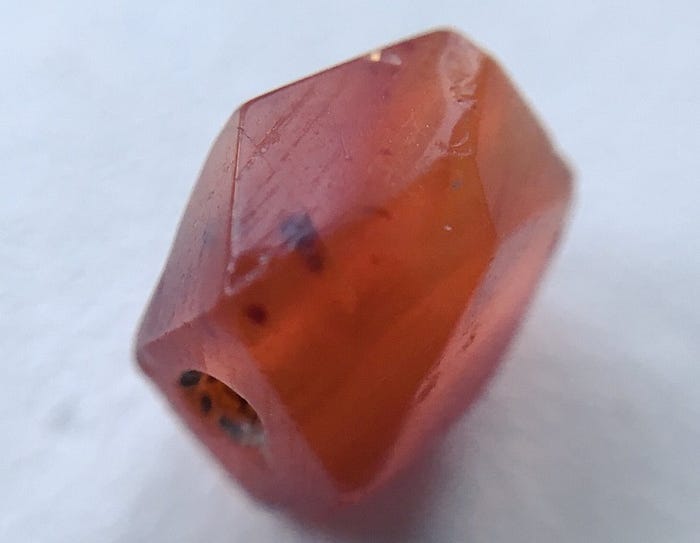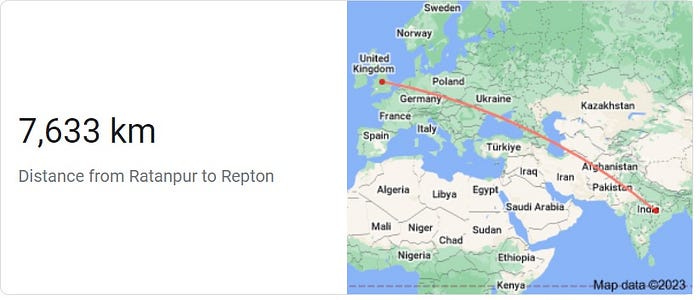How A Viking Raider In England Acquired Beads From India
A small piece of jewelry reintroduces us to the most brutal entrepreneurs who ever lived

“In 1982…archeologists excavating a Viking winter camp in the sleepy Derbyshire village of Repton found a small orange bead among the jumbled up bones of nearly three hundred people buried there in a mass grave.”
— River Kings: A New History of the Vikings from Scandinavia to the Silk Roads by Dr. Cat Jarman
The bead mentioned above — along with some of its brothers and sisters — sat in a plastic bag within a museum for over thirty years. On its surface, they were nothing special. Well, until science could tell us otherwise.
Bioarcheologist (think archeologist, biologist, and scientist mixed together) Cat Jarman examined the beads in 2019. She found they were common…in India.
In her interview with India’s Financial Express, Jarman reveals the jewelry were carnelian beads made in a region called Ratanpur in Gujarat, India. In fact, the area still makes the same beads their ancestors did. While that’s interesting, I’m sure your mind is racing with a question.
How did a Viking who died in 873 AD get beads from India?
Furthermore, this wasn’t just any Viking. This one happened to be in England; part of the Great Heathen Army which ravished the English countryside, capturing many kingdoms.
And “Heathen” is a good idea of the stereotype which follows these sea-borne raiders throughout their history. Obviously, for a reason. In her book, Jarman explains they slaughtered, raped, practiced human sacrifice, and regularly sold captives into slavery.
But despite their savagery, they also set up a vast trade empire, which spanned from Christian West, pagan North, and Islamic East. That’s just some of the Viking’s many faces. According to Jarman in her interview:
“I like to think of them as entrepreneurs…Sometimes they plunder, sometimes they raid, sometimes they trade, sometimes they are peaceful, sometimes they settle. They did what they needed to do under given circumstances…That is part of the Viking success, that they can adapt. They can go east, south, and north.”
Through these odd characters in long boats, we get a view of the old world much different than we normally imagine. Namely, it wasn’t isolated. The globe was connected, and trading.
One only has to follow the money.
A Travel Map Marked With Silver
In 2007, a horde of ninth century Viking silver was discovered in York, England which came to be known as the Vale of York Horde. It was made up of over six hundred coins. But the impressive part was their origin, not the number.
Maev Kennedy and Martin Wainwright’s article in The Guardian explains the coins came from locations as diverse as “Samarkand in central Asia, Afghanistan, Russia and north Africa.”
Jarman in her book also notes the cup that contained the treasure — made of silver and gold — came from France. Besides the coins, there was also a “Permian band,” or a wearable form of currency, from the Ural Mountains.

Furthermore, the cup held silver melted into ingots and pieces cut off these called “hack silver,” used for smaller transactions.
Oddly, some coins appear to have come from Viking settlers in England, with one side showing a Christian saint and another Thor’s hammer. It seemingly indicates a blend of cultures.
Finally, this is rounded out by silver Dirham coins from the Islamic Caliphate. Strange I know. But the Vikings had intimate dealings with the center of Islam, and Muslim silver was an integral part of their economy.
And speaking of economy, their method of handling money further illustrates the idea of Vikings as a type of rough versatile entrepreneur.
A Twin Payment Driven Economy
Within River Kings, Jarman explains the Vikings had a “dual economy,” which could either trade via currency (like ours), or a “bullion economy.” The latter was based on weight.
This effectively allowed the Vikings to do business across the known world. Where coinage reigned, they used coins. But since most were made of silver, they could also weigh out payments to come to values they desired.
In sections of their world where the bullion economy was standard, Vikings melted down coins into ingots or bars which could be stored or traded by weight. Furthermore, they could cut pieces which became hack silver.
This fostered a powerful desire for this precious metal, which only the Islamic caliphate could fulfil with their dirham coins. According to Jane Kershaw in the journal Antiquity:
“The primary source of silver fueling the Scandinavian bullion economy was Arabic silver dirhams, acquired by Scandinavians in Russia through the sale of slaves and furs. Dirhams were brought back to Northern Europe in tremendous quantities beginning in the early to mid-ninth century. Numbers recorded from the Scandinavian countries, predominantly belonging to a 100-year period of AD 840–940, total in excess of 170,000.”
There also seems to be some convergence between the Scandinavian weight system and Islamic coinage, likely driven by how much contact there was.

But the dirhams also made their way to England, traveling with the Viking raiders.
Jarman says small devices that looked like dice were discovered in a Viking camp near Repton too, but these weren’t game pieces. They were weights, primarily used in trading silver.
Moreover, the Permian bands previously mentioned allowed the wearer to carry their currency with them. They always weighed some derivative of a hundred grams.
Intuitively, this changes things a bit. The money system and length of their trade networks alters that “heathen” image of the Vikings dramatically.
The UPS Service Of A New Silk Road
In her book, Jarman describes the Viking Great Heathen Army attacking England like a mixed group following a rock band. It wasn’t one people. Vikings came from all over Scandinavia, Denmark, and even Russia.
But they had a similar culture and could plug in and function. So the army could break up, reform, and reinforce with a mishmash of groups from around the Viking world without losing a step.
Their trade network also matched this adaptability, stretching from region to region, and bridging different payment networks.
They could also switch from trader to raider, and raider to settler when times demanded. Plus when all else failed, Vikings could export the greatest good they possessed: violence.
This versatility put them in a unique position. According to Jarman in her interview:
“The carnelian bead is essentially part of the Silk Road network. The Vikings are tapping into these networks of silk to go down to connect with the Silk Road to China, Baghdad and Constantinople. It was…an extension of the networks that were already there, and the Scandinavians are connecting to them..”
So, how did an Indian bead make its way to a Viking burial ground in England? Consider them the UPS of the medieval world. Their uniqueness allowed them — for a time — to be the ultimate middlemen of a newer Silk Road.
But with a twist.
Sometimes your UPS driver burns down your house, steals your wife, kids, and everything you own. This is all reflected in a bead that traveled about five thousand miles.
Consequently, this piece of jewelry effectively reintroduces us to the most brutal entrepreneurs who ever lived. Call them UPS with an axe, long boat, and a taste for silver.
-Originally posted on Medium 1/29/23



